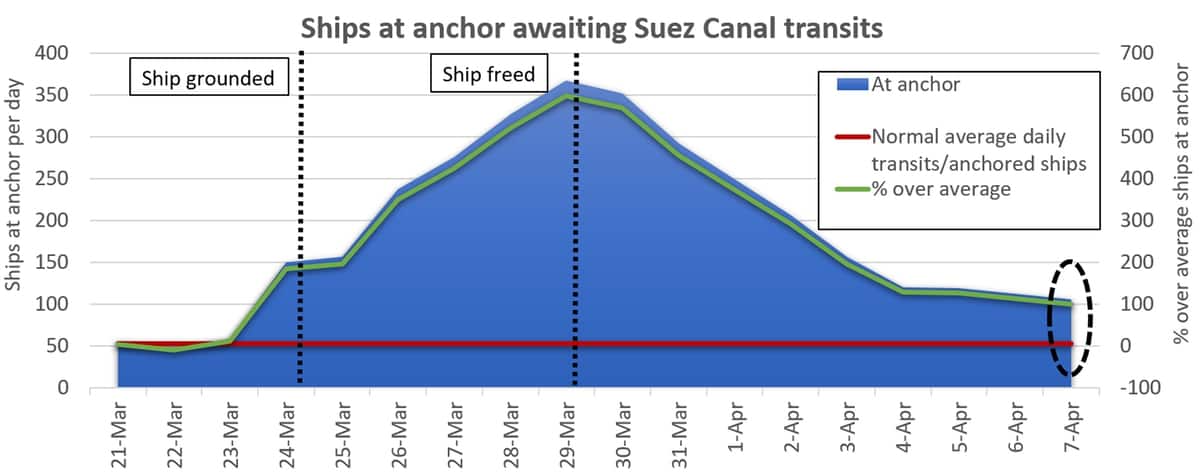The Ever Given was freed on March 29. Five days later, the managing director of the Suez Canal Authority (SCA), Adm. Osama Rabie, declared that all the ships blocked by the accident had transited “in record time.” Numerous media outlets reported that the backlog had been cleared. End of story.
Well, not so fast.
If you define “Mission accomplished!” as getting every ship to the other side that was blocked by the Ever Given before it was refloated, it’s over.
If you define success as getting back to normal — as in the flow of traffic prior to the grounding of the Ever Given on March 24 — it’s getting closer to normal, it’s on a good path, but this is not over quite yet.
More ships at anchor than usual
Prior to the accident, the norm was for ships to arrive prior to 11 p.m. on the day before the scheduled transit, anchor overnight and then pass through the canal.
Jacob Guldager, branch manager and business development manager of Leth Agencies, told American Shipper, “The daily transit average [prior to the accident] is 52.7 vessels: 26.8 northbound and 25.9 southbound. This will be equal to a ‘normal’ waiting-at-the-anchorage-area situation.”
On Wednesday, nine days after the Ever Given was freed and four days after the SCA sounded the “all clear,” 105 ships were at anchor: 55 on the Mediterranean side, 50 on the Red Sea side. Still twice the normal level.

Since the day the Ever Given was freed, an average of 70.7 ships have transited each day, including 85 on Thursday. That’s 34% more per day than usual. But the number of daily transits remains under the number of daily ships at anchor. This means that some ships still have to wait an extra day to transit.
Rapid reduction versus peak
The good news is that there’s no evidence of any significant post-Ever Given problem at the canal. Rather, it’s just taking longer to fully normalize than some might have anticipated. As ships blocked by the Ever Given grounding were brought through, more kept arriving. As those new arrivals were cleared over recent days, more ships arrived.
There was also a small setback on Tuesday. As reported by shipping agency GAC, a tanker ran aground. SCA tugs were deployed and the tanker was refloated four hours later.
GAC didn’t identify the ship, but MarineTraffic, using ship-positioning data, showed the vessel to be the tanker Rumford. MarineTraffic data also showed a brief stoppage for a second tanker, the Minerva Nike.
Despite delays related to that incident, the number of ships waiting at anchor on Wednesday was still less than a third of the March 29 peak of 367, according to data from Leth Agencies. (The SCA put the peak number even higher, at 422 ships.)
Furthermore, the queue has decreased more rapidly for container ships than for other segments such as dry bulk.
There were 29 bulkers at anchor on Wednesday but only 15 container ships. The number of waiting container ships was less than a sixth of the number at the peak (96 container ships).
Leth Agencies’ statistics show that an average of 13.7 container ships transited per day during January and February, just below the current tally. In other words, at least when it comes to the container sector, it looks very close to business as usual. Click for more articles by Greg Miller
Related articles:
Demand boom on collision course with ocean transport ceiling








Walter Kemmsies
What is the highest number of transits that the Suez Canal can safely handle? Is there such an estimate?